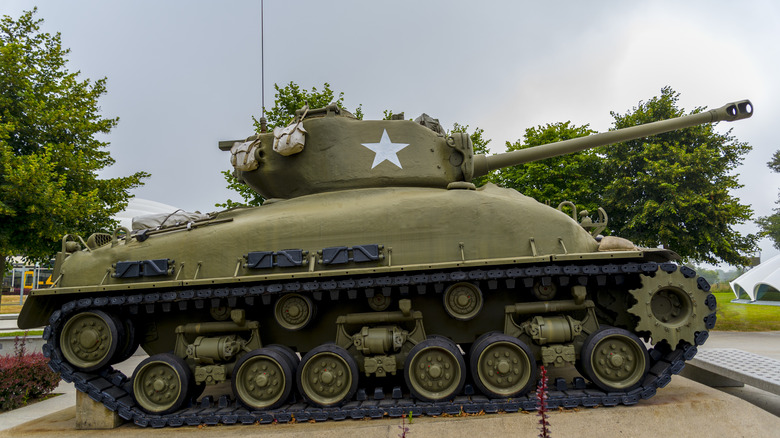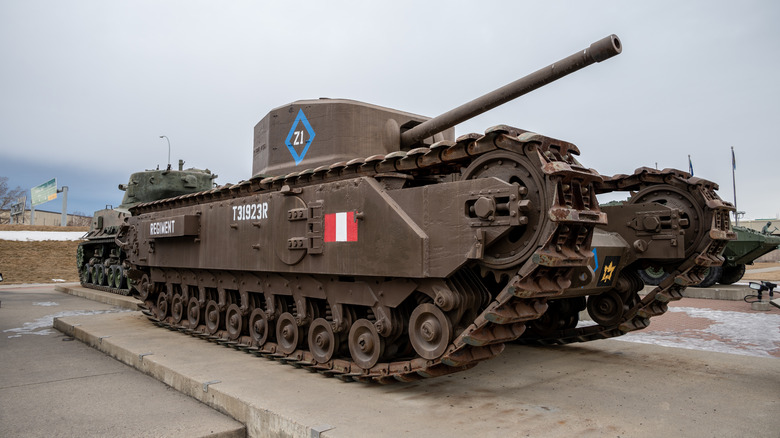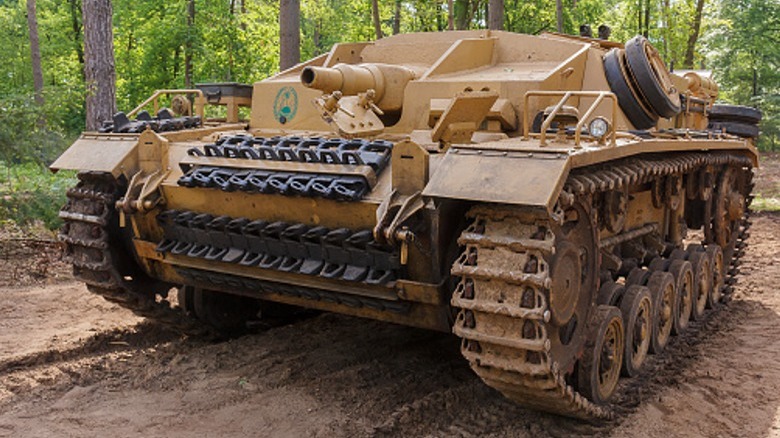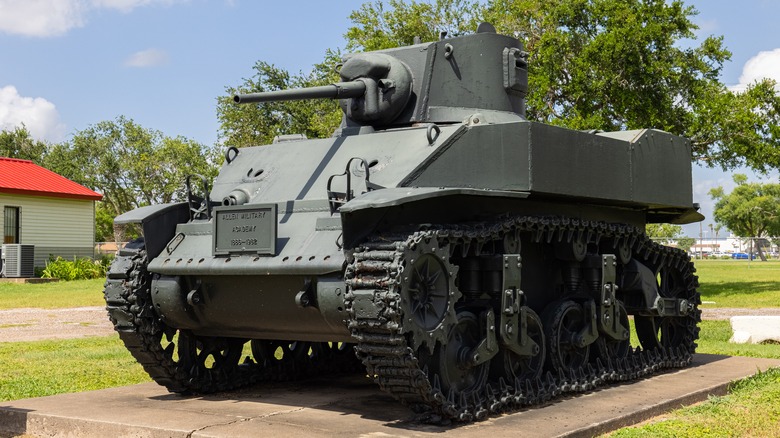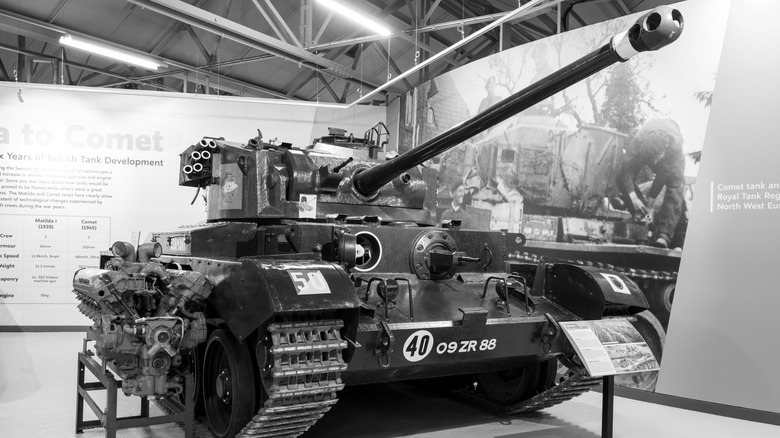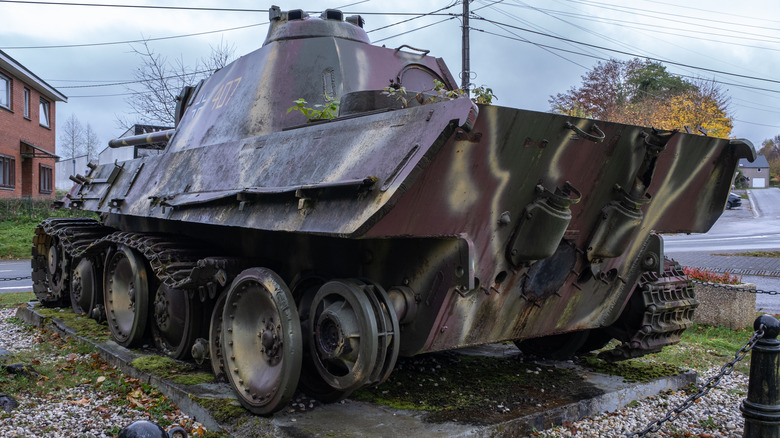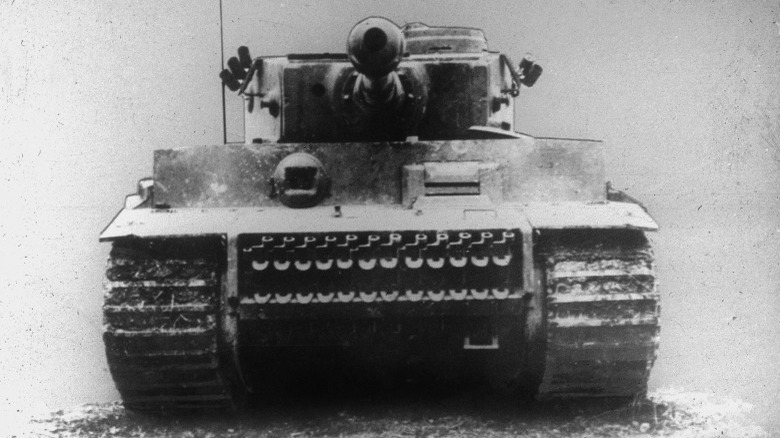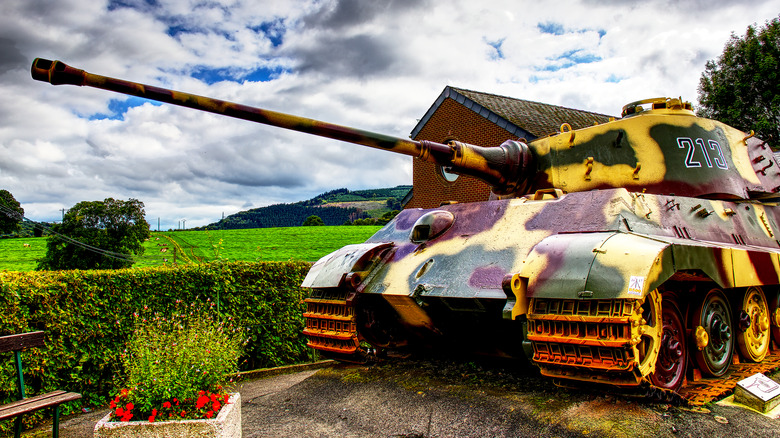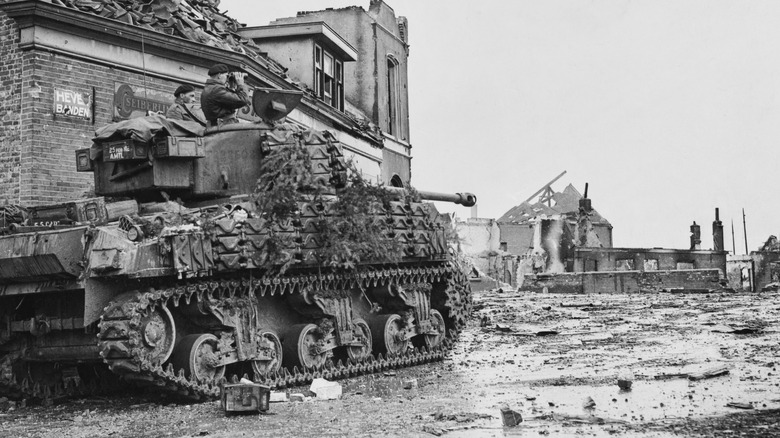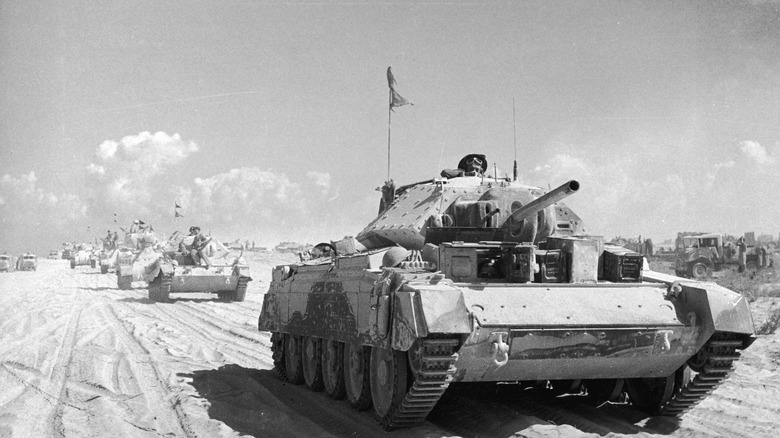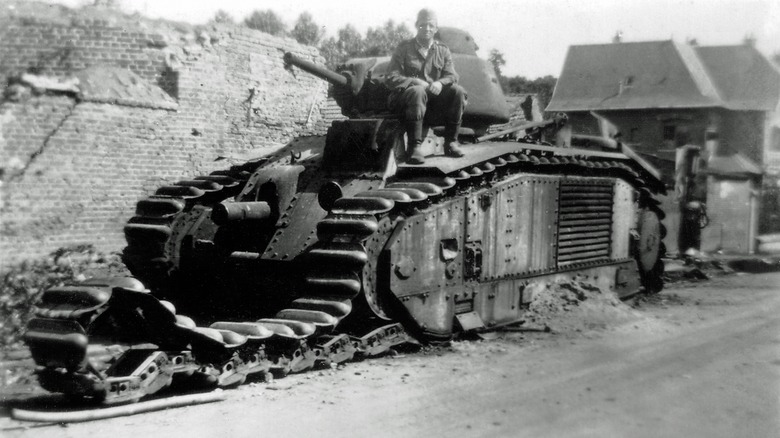The 10 Most Legendary Tanks Of WW2 Ranked From Worst To Best
They're big, intimidating, destructive, and possibly one of the most important assets utilized in World War II. The impact that tanks had on the battlefield during the global conflict cannot be understated, as they became game-changing weapons used by multiple countries. What tanks provided for one side in sheer power and mobility often resulted in severe casualties for the other.
The use of tanks in World War II was so prominent that at one point, a non-combat unit known as the Ghost Army was created explicitly to deceive the enemy by the use of inflatable tanks and other creative tactics to mislead the German army. While inflatable tanks are certainly something to be remembered, they aren't quite considered legendary in comparison to the other formidable fighters that had their tracks on the ground during the Second World War.
There were many types of innovative tanks that were developed and deployed during World War II, but here are 10 that rank higher than the rest.
10. Churchill
First deployed by the United Kingdom in 1941, the tank known as the A22 Infantry Tank Mk. IV — or simply, the Churchill tank — played a significant role in numerous military operations. Like most tanks, the Churchill was fitted with exceptional armor that made it highly resilient against enemy fire. The focus on the armor around the front of the tank made it especially prepared for direct heavy fire.
The Churchill was operated by a five-man crew, who commanded some extreme firepower including a 75 mm gun and several machine guns. The tank was made with longer-than-average tracks to handle difficult and unexpected terrain conditions. This meant it could assist on-the-ground troops and take on enemies in locations other tanks couldn't reach. This ability was put to the test in the 1944 invasion of Normandy, where a modified version was deployed against beach defenses.
The Churchill was utilized for almost the entirety of World War II, albeit with a few upgrades worked into its production over the years. This tank wasn't designed to impress anyone — it was designed for defensive and offensive destruction, both of which it achieved with aplomb.
9. StuG III
The Sturmgeschütz III, or StuG III tank, was a heavy-duty piece of equipment that kept a four-person inside crew well protected from other combat artillery while releasing an arsenal of firepower against the masses. Earlier tank models were equipped with a short-barrelled 75mm KwK 24 gun. The later models had a Stuk 40 gun that utilized a longer barrel and gave the tank even more firepower.
There was a staggering number of StuG III tanks produced. Most impressive may be the 7,720 Ausf G tanks made between 1942 and 1945, and these tanks served a wide variety of uses. One StuG III was even modified with radio equipment and an antenna in order to be used as a remote control tank to carry demolition charge.
The flexibility offered by the StuG III was partially enabled by the tank's hull, which was split between three sections – a forward-mounted transmission, a central crew compartment, and a rear engine compartment. This design added to its versatility and protective measures as the front compartment was protected by an angled heavy armor plate. The effectiveness of this close combat tank made it a useful piece of weaponry in World War II and a truly legendary tank.
8. M3 Stuart
The M3 Stuart tank was a speed machine — as far as tanks go — with a max speed of 36 miles per hour thanks to its powerful Continental W670-9A engine. At 28,500 pounds, the Stuart was considered light in comparison to other tanks, which played a huge role in its speed and maneuverability.
The British nicknamed the M3 Stuart Honey because while it wasn't the most powerful tank in terms of firepower, they favored its maneuverability. While the M3 Stuart was still a dangerous war machine equipped with a 37mm main gun and three .30 caliber machine guns, its firepower wasn't favored or even seen as necessarily threatening. In regards to its ability to damage German armor, one veteran stated in a quote published by The National WWII Museum that "Popcorn balls thrown by Little Bo Peep would have been just as effective."
The M3 Stuart didn't exceed any expectations in Europe but proved its worth in the Pacific. Japanese infantry would often take advantage of the difficult-to-navigate terrain and attempt to pry open the hatches of larger, slower-moving tanks to drop explosives inside. The M3 Stuart's lightweight and nimble maneuverability was an important asset during these battles that allowed it to assist other tanks.
7. Comet Cruiser Tank
The Comet Cruiser Tank may not have been around for as much of World War II as other tanks, but it still left a significant mark. When the Comet Cruiser did see battle its heavy sloped armor design gave it impeccable protection against incoming fire, which made it difficult for enemy forces to land a blow.
In terms of firepower, the Comet came ready to go with a 77 mm gun that could fire a 17-pound projectile through enemy armor up to 4 inches thick from up to 1,500 feet away. The Comet was a new and improved version of the Cromwell tank and around 1,200 of them were produced between 1944 and 1945. The improvements meant that operating crews would need to be trained on how to properly handle this new tank, which delayed its entrance into the war.
The top speed of 32 miles per hour and 125-mile range made the Comet Cruiser a top choice for missions needing to be carried out with haste. Comets were utilized in March 1945 during the crossing of the Rhine River at Wessel to force entry into Germany and continued to serve the British forces for years after the war ended.
6. Panzer V Panther
The Panzer V Panther tank was a German tank that was well-traveled in World War II. It was used in battles in Italy, France, Belgium, and Holland. There were over 6,000 of these tanks produced and its popularity may have been due to its impressive firepower. With a long-barreled, high-powered gun that could fire six rounds per minute and a storage capacity of 79 rounds of 75mm ammunition, this was one opponent you didn't want to make an appearance on the battlefield.
The tank's powerful engine and use of sloped armor to maintain a lighter weight gave it higher efficiency and made the Panzer V Panther a dream in terms of tank maneuverability. What the sloped armor took away in weight, it gave back in protection. Enemy fire was less likely to penetrate the armor because while the armor was only 80mm-thick, its sloped design meant that a round fired at the front of the tank would need to penetrate 139 mm of material, keeping the crew inside safe in combat.
Anti-tank mines were widely used by both sides in the war, and to combat this, the Panzer v Panther tanks were dressed with a Zimmerit anti-magnetic mine paste that allowed them to navigate into dangerous enemy territory.
5. Tiger I
The Tiger I tank is one of the best-known tanks of World War II for a few reasons. The armor alone was enough to make those operating it feel secure and those firing at it feel inadequate. The Tiger's armor was extremely thick at 100mm, keeping those inside protected from enemy fire.
The firepower on the Tiger I was equally impressive. The 88mm gun was able to penetrate armor as thick as its own from up to 1,000 meters away. The Tiger I was easily spotted on the battlefield due to its massive size and weight of 57 tons. However, its easy visibility and overall lack of camouflage wasn't an issue, though, because the protective armor along with its long-range, heavy-duty firing capability meant this tank wasn't one you'd want to see in your opponent's lineup.
The power of the Tiger I didn't come without some fallbacks as it did have a tendency to catch fire. Not exactly something beneficial to those counting on it. Regardless, this tank did enough damage throughout World War II to earn itself a legendary title.
4. Tiger King
The Tiger II, commonly known as the Tiger King, was the most powerful tank of 1944. It blew past enemy armor with its 88mm gun and two machine guns. If those weren't enough, the turret rear was removable to make room for the addition of another gun. This tank was the go-to for extreme firepower.
The Tiger King maintained a thick, sloped armor that came in handy on the battlefield — especially when the mechanical errors it was unfortunately prone to began acting up. The almost 70-ton weight of the tank made its maneuverability less manageable, but it still managed to prove incredibly valuable during its first battle in the 1944 Normandy campaign.
Overall, between 1944 and 1945 only 489 Tiger II tanks were produced. This is less than a lot of other tanks during World War II, but the impact and raw power of the Tiger King was so great that it made up for the lack of production.
3. M4 Sherman Firefly
The M4 Sherman Firefly began as a modified version of its M4 Sherman predecessor, which had already proved to be a valuable asset as it was easily produced and ultimately became the widely used tank deployed by the Allied forces with nearly 50,000 examples produced. However, to strengthen their forces ahead of the invasion of Normandy, the British unveiled these modified versions, and almost no time was wasted before a single Firefly took out five German Panther tanks on June 9, 1944 – sealing its spot in history.
Also known as the Mayfly, the M4 Sherman Firefly certainly packed a punch on the battlefield. If face-to-face with one in combat, enemies would be lucky if they were able to fire first. The firepower on the Firefly was exceptionally fierce with a QF 17-pounder anti-tank gun that easily gave it the capability to blast through enemy armor. The Firefly was the few Allied tanks present at Normandy that had enough power to penetrate the notoriously thick German Tiger I tank's armor.
The Firefly was primarily used by Britain and Canada, however after World War II they were used by Argentina, Belgium, India, Poland, South Africa, and Poland. Production-wise, just over 2,000 were made between 1944 and 1945.
2. Crusader Tank
The Crusader tank was one of the most popular tanks during World War II and was commonly used by the British in the North African campaign. The speed on the Crusader was impressive as far as tanks go, averaging 26 mph on roads and 19 mph off-road. Beyond that, at just 19 tons maneuverability was a breeze compared to most contemporary tanks. Both its speed and movement were highly coveted when carrying out various missions, especially those requiring the navigation of difficult terrain.
The Crusader could house a crew of four or five while supporting one or two machine guns to take out enemy soldiers. Possibly one of the most beneficial aspects of the Crusader tank was its Anti-Mine Roller Attachment which allowed it to venture into areas littered with mines that would take out most other tanks on the battlefront. Ultimately, however, it was the Crusader's benefits of speed and navigation that made it an incredible tool for those who had access to it during World War II.
1. Char B1
The Char B1 tank was developed by the French in the 1930s and had earned a reputation for itself as the best tank on the battlefield by May 1940. The armor on the Char B1 was 60mm thick and gave it impressive survivability in combat at the beginning of World War II. The Char B1 could also pack a punch with its well-stocked armament of a 75mm Howitzer that was positioned in the hull of the vehicle and a 47mm anti-tank gun mounted in a more traditional turret.
This firepower meant that the Char B1 was capable of blasting through the armor of even the most well-protected German tanks. Meanwhile, the B1's own armor kept it standing against the firepower of tanks like that of the 20mm gun on the Panzer II, which was the most commonly used tank by German forces during the invasion of France. Other Panzer models in service at the time, such as the Panzer III and Panzer IV, were only effective at close range.
The security and power provided by the Char B1 were respected by the German military, who commandeered them after the fall of France to use for their own Panzer Divisions. The Char B1 had impressed so many during its time in the war that German General Heinz Guderian hailed it as the best tank of all time. Despite the considerable flaws in its lack of a radio system, the Char B1 survived and blasted for years and in numerous combat zones throughout World War II and was sought after by multiple nations. Its offense, defense, power, and desirability help make it the most legendary tank of World War II.
